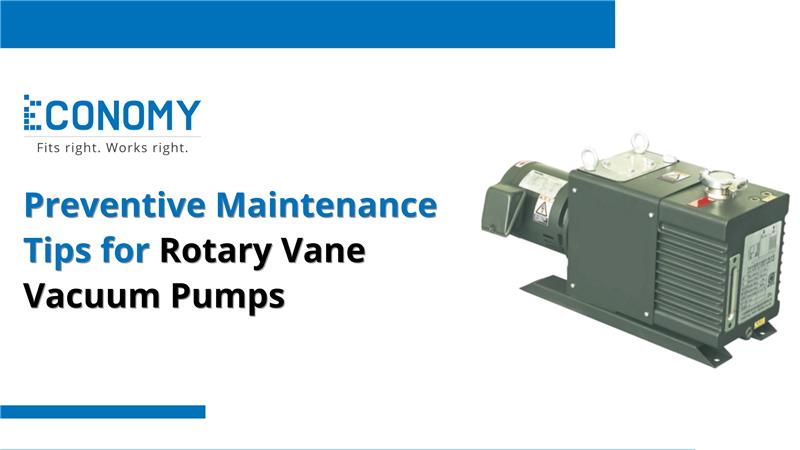A Brief about Rotary Vane Vacuum Pumps
Rotary vane vacuum pumps are widely used for their durability, efficiency, and adaptability across industries such as food packaging, chemical processing, and electronics manufacturing. These pumps consist of a rotor that spins inside a cavity with sliding vanes that create chambers of varying pressure, drawing air or gas into the pump and compressing it for discharge.
Oil-lubricated rotary vane pumps are the most common type, favored for their deeper vacuum capabilities. However, consistent upkeep is necessary to prevent internal wear, ensure effective lubrication, and avoid contamination-related failures.
Common Day-by-day and Weekly Maintenance Checks
Regular checks help maintain stable vacuum performance and extend the life of the equipment.
Daily Maintenance:
-
Check for unusual odors or smoke: Odors may indicate overheating or burning oil, often caused by poor ventilation or internal friction.
-
Monitor vacuum stability: Fluctuations in pressure during normal operation can point to system leaks or internal inefficiencies.
-
Observe oil bubbles in the sight glass: Excessive bubbling could suggest gas contamination or leaks from the process side.
Weekly Maintenance:
-
Tighten mounting bolts and hose connections: Loose components can cause vibration, leaks, or misalignment.
-
Check the condensate drain system: Ensure moisture and solvents are being properly separated to prevent internal corrosion.
-
Test the non-return valve: A malfunctioning valve can allow air back into the pump, reducing vacuum efficiency.
Tips for Monthly Preventive Maintenance
Monthly tasks help keep the internal components clean, aligned, and in good working condition.
-
Replace worn gaskets or seals: Aging or degraded seals can lead to pressure leaks and reduce vacuum efficiency.
-
Inspect for carbon buildup: Especially at the exhaust port or oil mist separator, where high operating temperatures can cause deposits to form.
-
Check shaft alignment: Misaligned shafts between the motor and pump can cause uneven wear and excess energy consumption.
-
Review power consumption: Increased energy use may signal reduced pump efficiency or internal component wear.
Commonplace Signs that Your Rotary Vane Pump Requires Care
Early identification of issues prevents damage and minimizes downtime.
-
Longer evacuation times: A pump that takes more time to reach its standard vacuum level may have worn vanes or a blocked inlet.
-
Frequent oil changes: If the oil degrades or becomes contaminated quickly, the pump may be ingesting process vapors or moisture.
-
Unusual operating sounds: Grinding or chattering sounds can mean internal damage or failing bearings.
-
Visible carbon or oil residue on the exhaust outlet: Indicates ineffective oil separation or combustion by-products from overheated oil.
Best Practices for Rotary Vane Pump Maintenance
Adopting proactive strategies ensures consistent performance and reduces unexpected failures.
-
Install a gas ballast valve: This prevents condensation of vapors in the oil, especially important in applications with high moisture content.
-
Operate within the design limits: Never exceed the pump’s recommended inlet pressure, vacuum level, or temperature range.
-
Flush the pump periodically: Use flushing oil or light mineral oil to clean internal parts and remove debris during scheduled maintenance.
-
Use inline traps or condensers: These protect the pump from corrosive vapors and particulates, especially in chemical or laboratory environments.
-
Create a customized maintenance checklist: Base it on the specific application, frequency of use, and environmental conditions.
Common Troubleshooting Tips
These quick interventions can help you identify and resolve common issues before calling for technical support:
| Issue | Likely Cause | Recommended Action |
|---|---|---|
| Pump fails to reach base vacuum | Leaking seals, worn vanes | Check for leaks, inspect vanes |
| Oil turns milky or foamy | Moisture ingress | Replace oil, check gas ballast function |
| Frequent thermal shutdowns | Poor ventilation, high ambient temps | Improve airflow, check fan functionality |
| Loud knocking noise during run | Oil starvation, loose vanes | Check oil level, inspect vane movement |
| Excessive backpressure at exhaust | Clogged oil mist separator | Clean or replace separator filter |
Proper rotary vane vacuum pump maintenance is a small investment with significant returns. It minimizes unplanned outages, optimizes energy usage, and ensures process consistency. By implementing a preventive approach—based on routine inspections, timely part replacement, and adherence to manufacturer recommendations—you can significantly extend your pump’s service life and maintain performance across demanding applications.
- Preventive Maintenance Tips for Rotary Vane Vacuum Pumps
- Proper maintenance of rotary vane vacuum pumps is a small investment with significant returns. It minimizes unplanned outages, optimizes energy usage, and ensures process consistency.
- Rotary vane vacuum pump maintenance ,Preventive maintenance for vacuum pumps ,How to maintain a rotary vane pump ,Vacuum pump oil change guide ,Common issues in rotary vane vacuum pumps ,Vacuum pump troubleshooting tips ,Best practices for rotary vane pump maintenance ,
Related posts:
 Discover the Best Fence Installation Services in Omaha with Huskins Services LLC
Discover the Best Fence Installation Services in Omaha with Huskins Services LLC
 Top Temperature Data Logger Manufacturers in India – Reliable & Accurate Solutions Powered by Nimbus Technologies
Top Temperature Data Logger Manufacturers in India – Reliable & Accurate Solutions Powered by Nimbus Technologies
 GCC Augmented Reality Market Size, Forecast 2025-2033: A Comprehensive Industry Analysis
GCC Augmented Reality Market Size, Forecast 2025-2033: A Comprehensive Industry Analysis
 Embracing the Call — Supporting Life Through Christian Faith
Embracing the Call — Supporting Life Through Christian Faith
 Make Waves on Your Birthday with SunFunFTL’s Luxury Boat Rentals in Fort Lauderdale
Make Waves on Your Birthday with SunFunFTL’s Luxury Boat Rentals in Fort Lauderdale
 Biodegradable Packaging Trends Across Asia-Pacific & Global Markets
Biodegradable Packaging Trends Across Asia-Pacific & Global Markets
 How to Use Magazine WordPress Themes to Create a Unique News Experience
How to Use Magazine WordPress Themes to Create a Unique News Experience
 What Should You Know Before Choosing a Book Printing Company?
What Should You Know Before Choosing a Book Printing Company?








